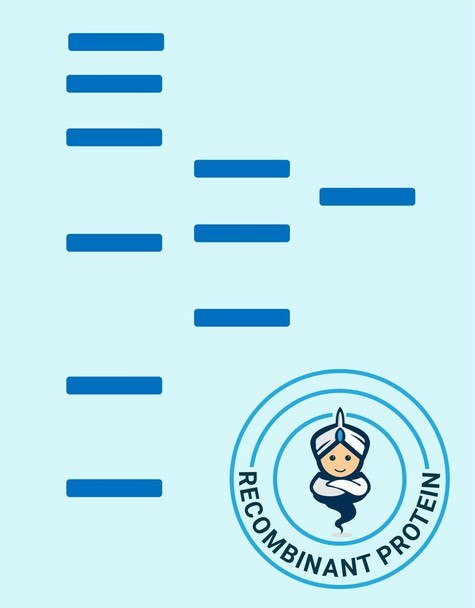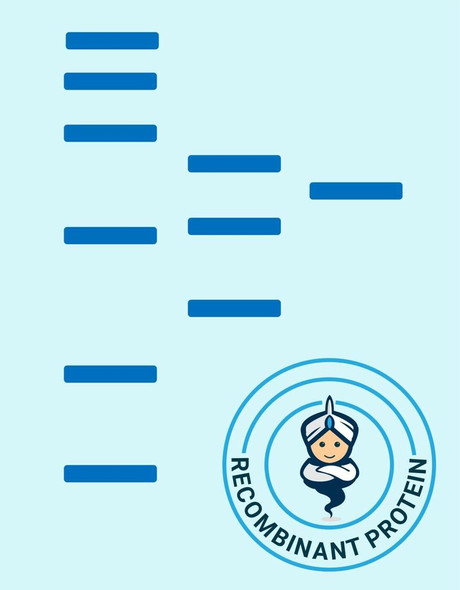Cytokines Recombinant Proteins
Human GDF3 Recombinant Protein (RPPB0302)
- SKU:
- RPPB0302
- Product Type:
- Recombinant Protein
- Species:
- Human
- Uniprot:
- Q9NR23
- Research Area:
- Cytokines
Description
| Product Name: | Human GDF3 Recombinant Protein |
| Product Code: | RPPB0302 |
| Size: | 20µg |
| Species: | Human |
| Target: | GDF3 |
| Synonyms: | Growth Differentiation Factor 3, Growth/Differentiation Factor 3 , MCOPCB6, MCOP7, GDF-3, KFS3. |
| Source: | Escherichia Coli |
| Physical Appearance: | Filtered White lyophilized (freeze-dried) powder. |
| Formulation: | The protein was lyophilized from a concentrated solution (0.5mg/ml) containing 30mM Acetate buffer pH-4. |
| Solubility: | It is recommended to reconstitute the lyophilized GDF3 in sterile 100mM Acetate buffer pH-4 at a concentration of 0.5mg/ml. For the dilution into higher pH values, it is recommended to dilute the protein to a concentration of 10?g/ml. Please note that in higher concentrations the solubility of GDF3 is limited. The protein is not sterile! Please sterile filter before using it in the cell culture. |
| Stability: | Lyophilized GDF3 although stable at room temperature for 3 weeks, should be stored desiccated below -18°C. Upon reconstitution GDF3 should be stored at 4°C between 2-7 days and for future use below -18°C.For long term storage it is recommended to add a carrier protein (0.1% HSA or BSA).Please prevent freeze-thaw cycles. |
| Purity: | Greater than 90.0% as determined by SDS-PAGE. |
| Amino Acid Sequence: | MKHHHHHHAS AAIPVPKLSC KNLCHRHQLF INFRDLGWHK WIIAPKGFMA NYCHGECPFS LTISLNSSNY AFMQALMHAV DPEIPQAVCI PTKLSPISML YQDNNDNVIL RHYEDMVVDECGCG |
GDF3 is a member of the TGF-beta superfamily though it does not show similarity pattern of conserved cysteine residues. GDF3 is linked to Vg-1 and human BMP-4. GDF3 transcripts are identified mainly in adult bone marrow, spleen, thymus, and adipose tissue. GDF3 expression is upregulated strongly in high-fat-fed C57Bl/6J FABP4/aP2 null mice, which develop obesity but not the related hyperglycemia or hyperinsulinemia characteristic of type II diabetes. GDF3 expression therefore bonds fatty acid metabolism in adipocytes and the expression of a differentiation regulator belonging to the bone morphogenetic proteins.
GDF3 Human Recombinant produced in E.Coli is a single, non-glycosylated, polypeptide chain containing 124 amino acids and having a total molecular mass of 14.15 kDa.GDF3 is fused to a 10 amino acid His Tag at N-terminus and purified by proprietary chromatographic techniques.
| UniProt Protein Function: | GDF3: Defects in GDF3 are the cause of Klippel-Feil syndrome type 3 (KFS3); also called Klippel-Feil syndrome autosomal dominant 3. KFS3 is a skeletal disorder characterized by congenital fusion of cervical vertebrae. It is due to a failure in the normal segmentation of vertebrae during the early weeks of fetal development. The clinical triad consists of short neck, low posterior hairline, and limited neck movement. Defects in GDF3 are the cause of microphthalmia isolated with coloboma type 6 (MCOPCB6); also called isolated colobomatous microphthalmia 6. MCOPCB6 is a disorder of eye formation, ranging from small size of a single eye to complete bilateral absence of ocular tissues. Ocular abnormalities like opacities of the cornea and lens, scaring of the retina and choroid, cataract and other abnormalities like cataract may also be present. Ocular colobomas are a set of malformations resulting from abnormal morphogenesis of the optic cup and stalk, and the fusion of the fetal fissure (optic fissure). Defects in GDF3 are a cause of microphthalmia isolated type 7 (MCOP7). MCOP7 is a disorder of eye formation, ranging from small size of a single eye to complete bilateral absence of ocular tissues. Ocular abnormalities like opacities of the cornea and lens, scaring of the retina and choroid, cataract and other abnormalities like cataract may also be present. Belongs to the TGF-beta family. |
| UniProt Protein Details: | Protein type:Secreted, signal peptide; Cytokine; Secreted Chromosomal Location of Human Ortholog: 12p13.1 Cellular Component: cytoplasm; extracellular space Molecular Function:cytokine activity; protein kinase binding; transforming growth factor beta receptor binding Biological Process: cell development; eye development; negative regulation of BMP signaling pathway; negative regulation of epidermal cell differentiation; regulation of apoptosis; regulation of cell fate commitment; regulation of MAPKKK cascade; skeletal development Disease: Klippel-feil Syndrome 3, Autosomal Dominant; Microphthalmia, Isolated 7; Microphthalmia, Isolated, With Coloboma 6 |
| NCBI Summary: | The protein encoded by this gene is a member of the bone morphogenetic protein (BMP) family and the TGF-beta superfamily. This group of proteins is characterized by a polybasic proteolytic processing site which is cleaved to produce a mature protein containing seven conserved cysteine residues. The members of this family are regulators of cell growth and differentiation in both embryonic and adult tissues. [provided by RefSeq, Jul 2008] |
| UniProt Code: | Q9NR23 |
| NCBI GenInfo Identifier: | 46397885 |
| NCBI Gene ID: | 9573 |
| NCBI Accession: | Q9NR23.3 |
| UniProt Secondary Accession: | Q9NR23,Q8NEJ4, |
| UniProt Related Accession: | Q9NR23 |
| Molecular Weight: | 41,387 Da |
| NCBI Full Name: | Growth/differentiation factor 3 |
| NCBI Synonym Full Names: | growth differentiation factor 3 |
| NCBI Official Symbol: | GDF3�� |
| NCBI Official Synonym Symbols: | KFS3; MCOP7; MCOPCB6�� |
| NCBI Protein Information: | growth/differentiation factor 3 |
| UniProt Protein Name: | Growth/differentiation factor 3 |
| Protein Family: | Growth/differentiation factor |
| UniProt Gene Name: | GDF3�� |
| UniProt Entry Name: | GDF3_HUMAN |






